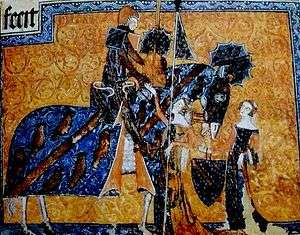Geoffrey Luttrell
Sir Geoffrey Luttrell III (1276 – 23 May 1345) lord of the manor of Irnham in Lincolnshire was a mediaeval knight remembered principally today as having commissioned the Luttrell Psalter, a rare and profusely illustrated manuscript now in the British Library in London.


Origins
He was the son of Robert Luttrell (died 1296) and a descendant of Sir Geoffrey de Luterel.[1] He was referred to as the 2nd Lord of Irnham. His family's arms were: Azure, a bend between six martlets argent. Another branch of the Luttrell family, which bore the same arms but differenced by tincture (Or, a bend between six martlets sable), in 1376 acquired Dunster Castle in Somerset, where they were seated until the extinction of the male line in 1737 (although the family continued at Dunster until 1976 via a female line which adopted the surname and arms of Luttrell).
Career
Within the last five years before his death in 1345 he commissioned the Luttrell Psalter,[2] the illustrations to which include a representation of him, his wife and his daughter-in-law, with profuse display of his armorials.
Although he has been praised for his patronage of the arts, it has also been claimed that Luttrell, like many medieval landowners of his time, was capable of ruthlessness and violence.[3] A private war which he conducted together with his neighbour Roger de Birthorpe against the monks of Sempringham Priory was considered serious enough to warrant a Royal Commission of Inquiry in 1312.[4] However, it has been argued that Birthorpe was the principal offender and that Luttrell was to blame only for supporting his friend; this may be borne out by the fact that while Birthorpe was outlawed for a time, Luttrell seems to have escaped any censure.[5]
Notes
- Greater Medieval Houses of England and Wales, 1300-1500: East Anglia
- Heraldry, Pageantry and Social Display in Medieval England
- Coleman, J. "New Evidence about Sir Geoffrey Luttrell's Raid on Sempringham Priory 1312" British Library Journal (1999) pp.103-128
- Coleman p.103
- Coleman p.119
External links
- Inquisition Post Mortem #406, dated 1296, reflecting the inheritance going to his son Geoffrey.